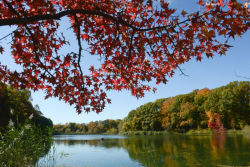Alley Pond Park
Freshwater Wetlands in New York City - Oakland Lake
New York City once contained 224,000 acres of freshwater wetland. This valuable ecosystem can slow erosion, prevent flooding by retaining storm waters, filter and decompose pollutants, and slow global warming by converting carbon dioxide into oxygen at a prodigious rate. In the past 200 years, the increasing demands of a growing metropolis have resulted in most of this land being filled for construction, or dredged for transport. Only 2,000 acres of freshwater wetland remain in the city today, and many species that once called the wetland home have been lost forever.
Oakland Lake is a 15,000-year-old spring-fed glacial kettle pond located in Alley Pond Park. Glacial boulders bank the 13 acres of Oakland Lake. The formation of wetlands can be traced back to the most recent ice age. A massive ice sheet called the Wisconsin Glacier advanced on New York City 75,000 years ago, pushing rock, soil, and boulders ahead. When the ice melted 17,000 years ago, water flowed to the sea, creating streams and rivers that carved through rock. Large glacial fragments broke off, melted, and left depressions called kettles. If layers of fine silt and clay were deposited on the bottom of the depressions, the kettles collected water and ponds formed. Where waters were shallow or flowed slowly, seeds and spores were able to take root and flourish. Generations of plants grew and decomposed, building peat-rich sediments. As wind and water eroded the soil, the steep slopes grew gentler, slowing the passage of water. Plant communities diversified under these favorable conditions, attracting animals that fed on the plants. The sophisticated food web that developed brought advanced predators to the wetlands: snapping turtles (Chelydra serpentina), wolves (Canis lupus), several species of hawks, and humans (Homo sapiens).
Water levels in wetlands are variable, influenced by the underlying rock and soil makeup, rainfall, season, and ground water inputs. Despite these variable conditions, freshwater wetlands teem with life. In the deeper waters of Oakland Lake, white water lilies (Nymphaea alba) and water milfoil (Myriophyllum spicatum) grow. In the sandy soil beneath the clear waters of the shallows are the ribbed veins of arrowhead (Sagittaria latifolia) and the blue spires of pickerelweed (Pontedaria cordata). Toward the southwestern end, near the ravine that carries the stream that feeds the lake, the waters are muddier. Arrow arum (Peltandra virginica) and common reed (Phragmites australis), a tall, invasive plant species, sway beneath the willows. Red maples (Acer rubrum), pin oaks (Quercus palustris), flowering dogwood (Cornus florida), sweetgum (Liquidambar styraciflua), and wild cherry trees (Prunus serotina) surround the lake elsewhere, and witch hazel (Hamamelis virginiana) and sweet pepperbush (Clethra alnifolia) grow beneath them.
Oakland Lake is home to fish, including bluegill (Leponis macrochirus), carp, perch, and bass. The natural diversity of the area also attracts birds, such as cardinals (Cardinalis cardinalis) and dark-eyed juncos (Junco hyemalis). Rusty blackbirds (Euphagus carolinus) can sometimes be seen here in March. The lake is home to many ducks, including mallards (Anas platyrhynchos) and lesser scaup (Aythya affinis). In addition to housing these native species, freshwater wetlands also provide resting, breeding, and feeding grounds for hundreds of thousands of migrating birds. Many of these birds arrive in New York City only twice a year as they travel along the Atlantic flyway, a major migratory route.
Check out your park's Vital Signs
Clean & Safe
Green & Resilient
Empowered & Engaged Users
Share your feedback or learn more about how this park is part of a
Vital Park System










